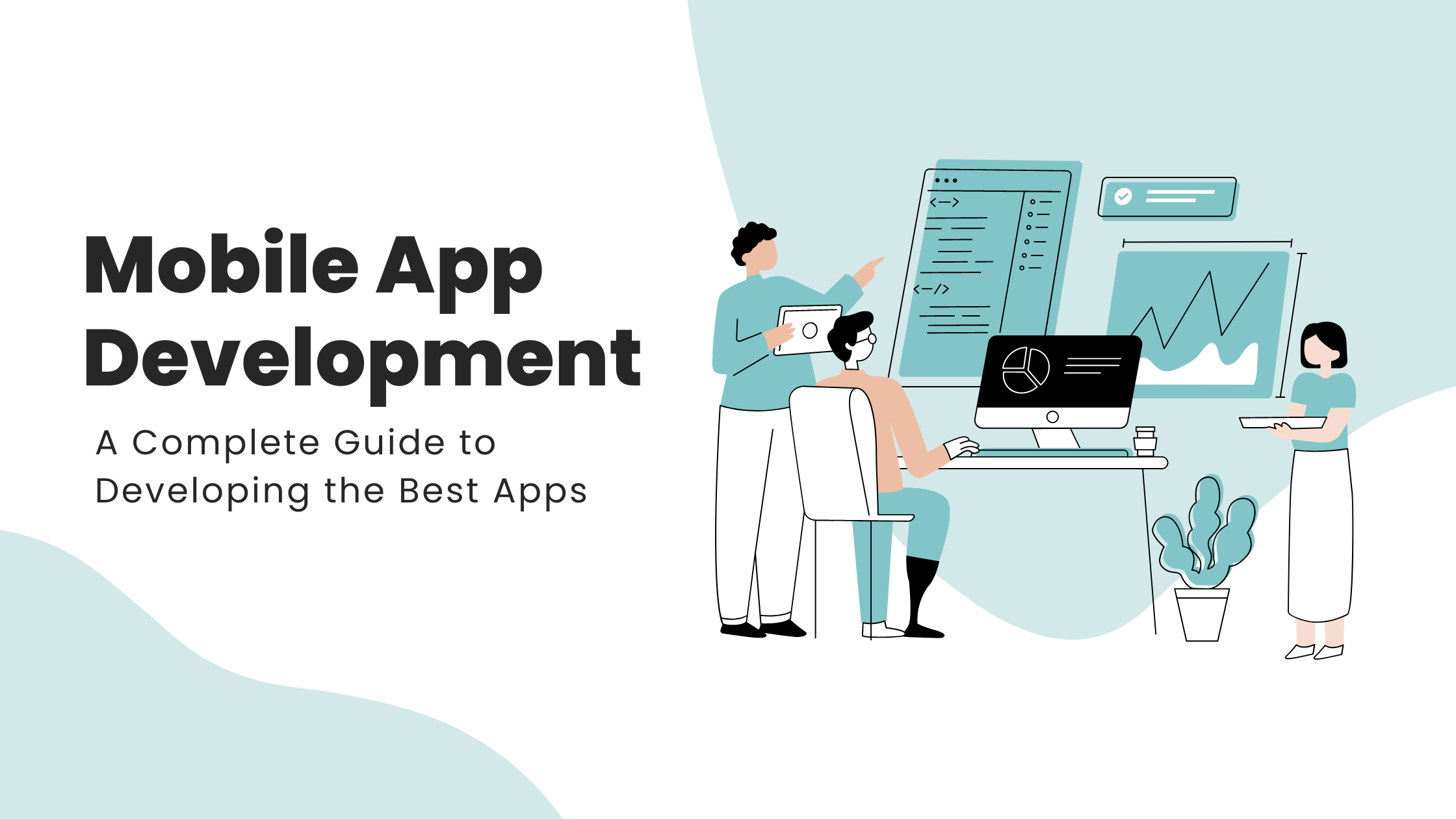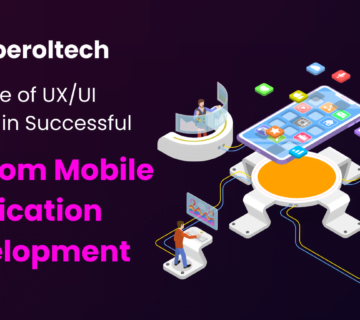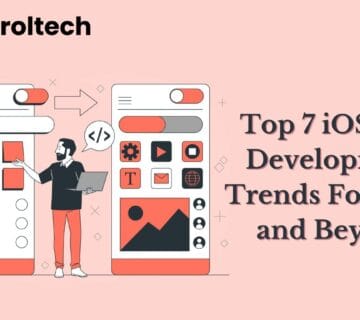So, you have a brilliant idea for a mobile app when you wake up in the morning. You can explain it, you know it’s the most amazing idea ever, and you know your app idea will astound many people. What do you do next?
The good news is that it’s off to a strong start. Unfortunately, few apps truly become successful. Then, is a little luck all that divides the good from the bad? Yes, along with a lot of wise moves. Despite the fact that luck may be learned, we are here to provide the right ways to build your software.
Let’s explore our in-depth guide to the mobile app development process if you’re thinking about creating one. To make things simpler for you to understand, we have distilled the entire guidebook. From definition to process, and platforms, we have covered it all.
So, let’s get started!!!

What Is Mobile App Development?
Mobile apps are specialized software programs that run on mobile devices (such as applications for smartphones and digital assistants) and use a network connection to connect to remote computer resources. Creating installable software packages, setting up backend services, and testing the application on target devices are all steps in the development process. Mobile app development is, in essence, the methodical process of effectively designing, creating, and deploying a mobile app.
As companies from many industries try to satisfy customer expectations and look for quick, simple ways to complete transactions and access information, the significance of developing a business mobile app is expanding quickly. By the end of 2023, 299 billion mobile apps are expected to have been downloaded globally.
There are various major platforms you can develop your application on such as Android, iOS, and Hybrid. You may take full advantage of all the features provided by the mobile OS and device by using a well-structured mobile app. The development approach considers the constraints of mobile devices and enables you to strike a balance between cost and usefulness.
Mobile App Development Process
Refine The Idea And Strategize
Before you start, you must first make a list of all of your prospective ideas for software development. Maybe some of you already have a basic idea or concept. Some individuals may be taking their first steps.
Here are some good opening questions that you should be posing to yourself:
- What do you hope your mobile application will achieve?
- What aims does your app have?
- Which problems would your app fix for users?
- What functionalities will be present in your app?
- How much funds are you prepared to put up?
- How will the app be created? (In-house group, firm, mobile application developer, etc.)
Getting carried away while brainstorming is simple. However, it’s crucial to stick to the app’s main functions. Shift your focus from the “nice-to-haves” or extras that aren’t necessary but take the focus away from the app’s main purpose.
Market Research
Now comes the most crucial aspect of your mobile app development journey – Market Research. A detailed list of criteria that will help you define priorities for the assignment will be provided by the study since market research exposes the actual demand or interest of the market, allowing you to modify your original notion. Of course, the issue at hand is how to carry out market research effectively. Review the complete process of market research here:
- Define your objectives and customer persona
- Prepare your research survey questions
- Choose a section of that persona to interact with.
- Speak to people in your target customers
- Keep the survey informative
- List your market competitors and do the desk survey as well.
Here are some more benefits of conducting market research:
- It helps you keep a better understanding of your clients.
- Learn everything you can about your rivals.
- assessing your products carefully before release aids in determining your target market
- Determine the commercial opportunities
- learn about the features that are offered and what the public desires.
Build Your UX Design
Another essential step in the process is the design of the mobile application. Now, think about the look and feel of your app. Make some sketches and wireframes to get a sense of how the app will work.
The main priority should be the user’s experience. Make sure the user interface is user-friendly and smooth.
- Make a roadmap or storyboard to show how each screen is connected to the others.
- Consider the variations in how users will interact with your app and a mobile website (app development and web development are not the same).
- Your priority should be the user experience.
Make some prototypes of the app based on your wireframe before starting to design a fully working app. The main objective of this simple program is accomplished without the use of bells and whistles.
App Development
Now it’s time to start creating the application. This includes all back-end technology, APIs, and front-end development. You must take the following actions:
- Select a development strategy.
- Get your development team together.
- Make a project manager selection.
- Create a timeline with objectives and goals.
- Be flexible and get ready for alterations along the route.
Depending on your development technique, you might need to produce two distinct versions of the app—one for iOS and one for Android. Instead, you can use cross-platform development tools to create an app that works with both operating systems.
Everybody will have a somewhat different interpretation of this technique. Some applications can be created by a single developer in a month. Others may require several mobile application developers and take six months or a year.
The intricacy of the features in the kind of software you’re producing will have a big impact on how long it takes to develop it and how much it will cost. Building a simple app with fundamental functionalities ought to be quick and inexpensive. However, it will definitely take longer to construct complex software that requires user authentication servers, GPS capabilities, real-time communication between users, and other features of a similar nature. Aperoltech is the best mobile app development agency that can help you develop mobile applications with any platform.
Testing
Before releasing your application to the public, make sure it runs well. Before your clients may use your app, you must repair any bugs, kinks, or other problems that you find during testing.
- The best approach is to regularly test your app using QAs throughout the development stage.
- Check to see if both platforms have been tested for the app.
- Test the app on many platforms (smartphones, tablets, etc.).
- Real users should be included in experiments to gather input and make modifications.
No app is flawless. Providing a functioning app that runs without crashing so users may enjoy the experience is the goal of your testing.
Later on, you can upgrade your app and roll out new versions. However, if you try to make the app perfect during the testing phase, your app might never be made public.
What Are The Best Mobile App Development Platforms?
Flutter
Flutter is known to be the best UI toolkit for developing native mobile, web, and desktop applications. Widgets that are completely changeable make it simple and quick to create native mobile applications. Because of its layered architecture, component rendering will be speedy.
Features of Flutter
- Built-in Cupertino Widgets
- Supports both Android and iOS platforms
- Can develop high-performing applications
- Rich motion APIs
Microsoft Xamarin
With the help of Xamarin’s add-ins for Microsoft Visual Studio, developers can create C#-based apps for Android, iOS, and Windows. The use of Xamarin is preferred because it permits code sharing across several platforms, such as cross-platform mobile app development.
As a platform for creating cross-platform, open-source apps, Xamarin is renowned for providing a development ecosystem with a back-end, API, and components. Here are the top programs created with Xamarin.
Additionally, many tools, libraries, and programming languages support it. Additionally, it features a cloud service that enables testing across an unlimited number of devices.
Features of Xamarin
- Produce fewer bugs and faster time
- Best backend infrastructure
- Allow application indexing and deep linking
Adobe PhoneGap
Adobe PhoneGap has received funding from both Adobe and Apache. This platform’s use in Android development is well-known.
Using PhoneGap allows you to create a single app that can run on all mobile devices, which is a plus. Additionally, you can connect the open-source desktop program to mobile devices.
Features of Adobe PhoneGap
- Compatible on all platforms
- Effectively works on JavaScript, HTML5, CSS3
- A strong backend and easy to develop an app
- Easy to integrate different libraries to improve the app
Different Types of Mobile Apps
The creation of apps today is very different from past iterations. Low-level code has been the only approach used for native development in the past. Therefore, if you wanted to create an iOS app for the Apple App Store or an Android app for the Google Play Store, you would have to start from scratch.
Today’s admittance requirements for creating apps, however, are significantly lower. For the creation of apps, more platforms, languages, and tools are used, and Javascript is applied for cross-platform scripts.
This makes creating native apps from scratch more simple for e-commerce firms, established companies, and entrepreneurs.
The various app categories are listed below in brief, along with the unique aspects of each category’s development:
Native Mobile Applications
On a mobile device, native apps are installed directly. These are normally downloaded through the Apple Store or Google Play Store. Native applications typically operate without an internet connection and make use of the device’s built-in functionality.
The process of developing a native app involves writing code, specifically for the operating system of the device.
Cross-Platform Native Mobile Applications
The same code is used for every platform while creating applications with cross-platform. Therefore, you only need to create your code once, and both iOS and Android devices can install the app natively.
From the perspective of the user, there is hardly any difference between native and cross-platform native apps. From a development perspective, cross-platform native is more effective and less expensive.
Hybrid Mobile Applications
Although they are not the same, the terms hybrid and cross-platform are sometimes used interchangeably. Hybrid apps, like cross-platform apps, can be created once and run on both platforms.
However, hybrid app development is more user-friendly than cross-platform programming. The building of cross-platform apps is still very technical and demands app development expertise. Hybrid development requires minimal technical skills and can be completed using no-code app builders or a simple understanding of web programming.
Progressive Web Application (PWA)
PWAs are apps that are distributed through the web rather than being installed natively on a user’s device.
PWAs now have a user experience that is very comparable to that of a native app thanks to modern technology. Users can even receive push notifications, which are delivered through a web browser. However, PWAs’ ability to use a device’s native features will be somewhat constrained.
Read Also: How to submit your app to the App Store
Conclusion
The topic of mobile app development is complex. Whether creating cross-platform or native apps, the user experience must always come first.
The functionality of your app must correspond to its main use case, and the interactive elements must be simple to use.
The development of apps can take a tonne of different paths. Which option is best for you will depend on your budget, goals, schedule, technical know-how, and the complexity of the app.
Due to its expertise, Aperoltech is the ideal choice to take into account overall as it is the best mobile app development company in India. Additionally, we provide full-service app creation, which includes upkeep and support after launch.
Need to know more? To speak with one of our app development experts, request a free consultation.

FAQs
What Is Mobile App Development?
Mobile Application development is the process of building software for portable, wireless devices like smartphones and other handheld gadgets.
From where I can develop my mobile app?
There are several mobile application development companies in India. Aperoltech has India’s best mobile app developers that can help you develop any kind of mobile app according to your business requirements.
How much does it cost to develop a mobile app?
The cost of mobile app development depends on various factors like the type of application, features of the application, your business requirements, and much more. Get in touch with Aperoltech to know the best price.
What programming language is used for mobile apps?
JavaScript, Kotlin, C++, Python, Objective C, Swift, and many other languages are used for mobile applications.


